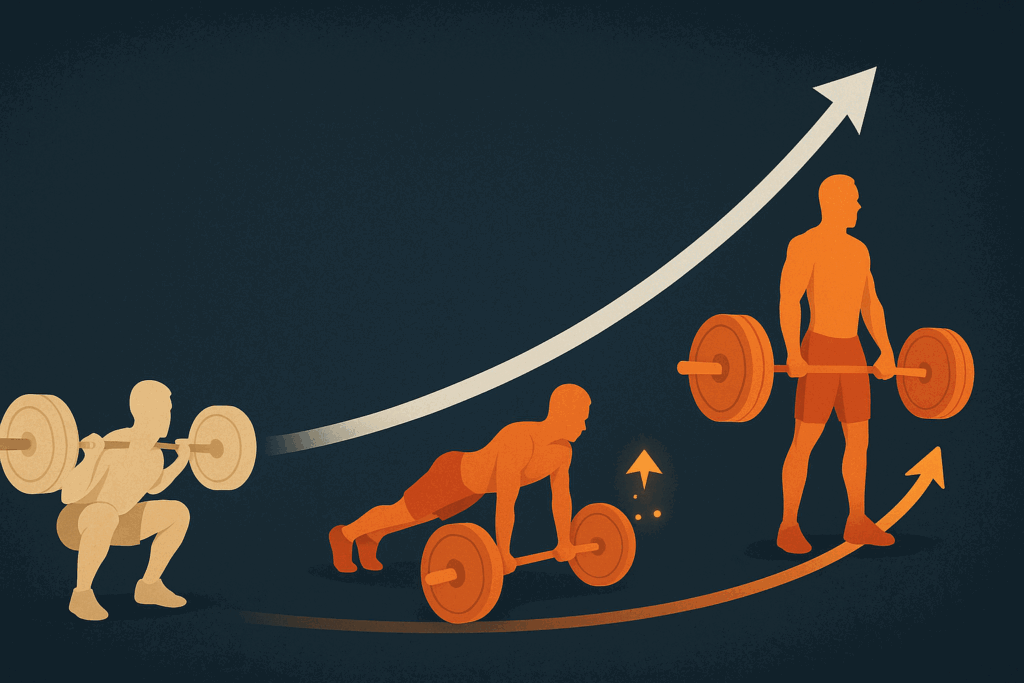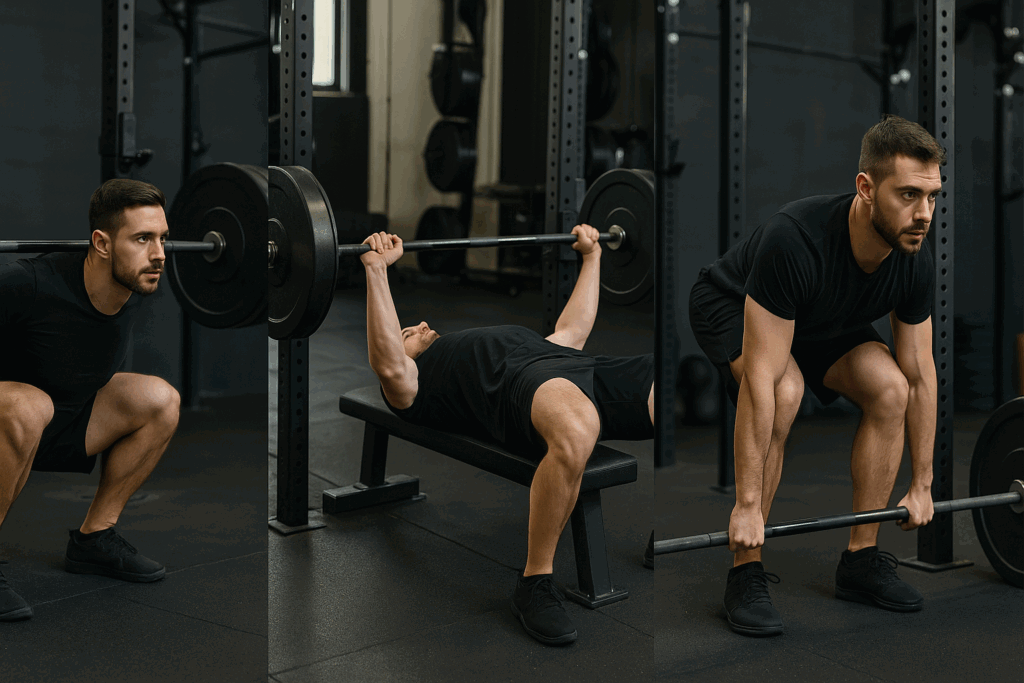Introduction: Why a Structured Powerlifting Plan Matters
Embarking on a strength journey without a clear roadmap is like trying to scale a mountain blindfolded. The overwhelming sea of gym advice, half-baked routines, and self-proclaimed gurus can leave even the most motivated lifters feeling directionless. That’s where a thoughtfully engineered 12 week powerlifting program PDF becomes a game changer. This comprehensive guide offers more than a list of exercises—it provides a coherent progression, integrating periodization, recovery, and individualized progression strategies to ensure measurable results.
Powerlifting, at its core, is a disciplined pursuit of mastery over the squat, bench press, and deadlift. These lifts demand not just raw strength but technical proficiency, mobility, and a deep understanding of the training process. A structured plan acknowledges this complexity by assigning the right stimulus at the right time. It balances volume and intensity, accounts for individual differences, and eliminates guesswork. Whether you’re a novice lifter looking to build foundational strength or an advanced competitor aiming to peak for a meet, the value of having a detailed, progressive program is undeniable.
This article delves into every aspect of such a program, helping you not only understand what makes a 12 week powerlifting program effective but also how to customize and maximize it. From scientific principles to practical application, you will find expert-level insights that make this more than just another downloadable powerlifting program PDF. It becomes your training blueprint for sustained growth.
You may also like: The Ultimate Powerlifting Program Template to Maximize Strength and Muscle Gains
Understanding the Anatomy of a 12 Week Powerlifting Program PDF
To truly appreciate the power of a well-structured powerlifting routine PDF, it is essential to dissect its anatomy. Most elite programs follow a logical and phased approach, typically broken down into three distinct blocks: hypertrophy, strength, and peaking. Each block has a unique purpose and physiological target, orchestrated to produce maximum strength output by the end of the 12-week timeline.
The hypertrophy phase, often encompassing weeks one to four, is designed to build muscle mass and work capacity. Lifters train in higher rep ranges, typically between 8-12 reps per set, with moderate intensity and a focus on accessory movements. This lays the muscular and metabolic groundwork needed for heavier loads later.
The strength block, usually weeks five to eight, shifts focus toward lower rep ranges and increased intensity. Compound lifts take center stage, and accessory work is fine-tuned to address weak points in the primary lifts. This phase stresses the neuromuscular system and reinforces technique under load.
Finally, the peaking phase comprises the last four weeks, where volume is reduced while intensity approaches maximal loads. The goal here is to maintain technical sharpness and prepare the lifter for personal records or competition. Tapering and rest become paramount during this period.
Each segment in the 12 week powerlifting program serves a strategic role. The magic lies in the sequencing—each phase prepares the body for the next, ensuring adaptation without overtraining. This strategic layering differentiates a true powerlifting training program PDF from generic, ineffective plans found online.

Key Variables That Shape an Effective Powerlifting Training Program PDF
The efficacy of any powerlifting program rests on a few fundamental training variables. When fine-tuned, these elements elevate a routine from basic to elite. These include volume, intensity, frequency, exercise selection, progression models, and recovery protocols. Understanding how to manipulate these variables is crucial for both designing and customizing a 12 week powerlifting program.
Volume, often expressed as total sets x reps x load, directly influences hypertrophy and muscular endurance. Higher volume is beneficial in early phases, while reduced volume helps peak strength. Intensity, typically denoted as a percentage of one-rep max (1RM), determines the neural load. A well-designed powerlifting program PDF modulates intensity across the weeks to balance stress and adaptation.
Frequency refers to how often each lift is trained per week. Novices might benefit from higher frequency to accelerate skill acquisition, while advanced lifters may require more recovery between sessions. Exercise selection balances specificity and variety. The primary lifts should dominate, but accessory work must target individual weaknesses and promote joint health.
Progression models, whether linear, undulating, or block-based, dictate how training stress increases over time. The best 12 week powerlifting program PDF will often include a blend of these models. Recovery, the often overlooked variable, encompasses sleep, nutrition, hydration, and active rest. Without it, progress stalls and injuries loom.
A great program doesn’t just prescribe sets and reps. It teaches lifters to adjust variables based on feedback, fostering autonomy and self-awareness—hallmarks of a mature strength athlete.

Building Technical Excellence: Squat, Bench, and Deadlift Fundamentals
No powerlifting program is complete without meticulous attention to the big three lifts. These movements are not just exercises—they are skills. Mastery requires intentional practice, biomechanical awareness, and consistent feedback. An effective powerlifting routine PDF must allocate sufficient volume and time to refine these movements under various conditions.
The squat challenges full-body coordination. It begins with stance width, bar position (high-bar vs. low-bar), and bracing mechanics. Depth must meet competition standards, which requires hip and ankle mobility, as well as spinal alignment. Programming squats multiple times per week using variations like front squats or pause squats can reinforce positioning and build depth consistency.
Bench pressing tests upper body strength, especially through the chest, shoulders, and triceps. However, success hinges on scapular retraction, proper leg drive, and bar path optimization. Addressing sticking points—such as mid-range stalls—often involves accessory work like close-grip benches or board presses. Technique drills and video reviews can significantly accelerate improvement.
The deadlift is perhaps the most neurologically taxing of the trio. From initial setup to lockout, it demands hip drive, lat engagement, and impeccable bar path control. Whether pulling sumo or conventional, the deadlift benefits from variations like Romanian deadlifts, block pulls, and deficit pulls to build strength across the range of motion.
Technical proficiency isn’t about perfection—it’s about repeatable efficiency. A powerlifting training program PDF that elevates your lifting IQ is one that not only includes these lifts but educates you on how to perform and refine them over time.

Structuring a Week Inside a 12 Week Powerlifting Program PDF
Weekly programming structure is where the long-term strategy meets day-to-day execution. A typical training week in a 12 week powerlifting program PDF features a balance of heavy, moderate, and volume-based sessions. This distribution allows for targeted stress on each lift while managing cumulative fatigue.
For example, Monday might include a heavy squat day, featuring back squats at 85-90% 1RM for multiple sets of three to five reps. Accessory work follows, emphasizing hamstring and core strength. Tuesday could focus on volume benching, combining flat bench presses at moderate intensity with accessory pushing and pulling movements to enhance upper body hypertrophy.
Wednesday serves as a rest or active recovery day, possibly incorporating light cardio, mobility work, or soft tissue release. Thursday returns to intensity with deadlifts at a high percentage, followed by glute and posterior chain-focused accessories. Friday rounds out the week with a bench variation, like close-grip bench, paired with high-rep dumbbell pressing and triceps isolation.
This structure is flexible and can be modified based on lifestyle demands, fatigue levels, or competition prep. A well-written powerlifting program PDF will provide alternatives, including three- or five-day variations. The goal is to maintain weekly balance while delivering consistent stimulus to the nervous and muscular systems.
Recovery days and sleep hygiene should also be integrated into the weekly rhythm. Training hard is only effective when paired with quality rest, making weekly programming an art of balancing intensity and recovery in pursuit of progressive overload.

Progressive Overload and Deloads in a Powerlifting Routine PDF
Progressive overload is the fundamental principle driving strength gains. It refers to the gradual increase in training stimulus over time—be it through heavier weights, more volume, or greater complexity. A high-quality powerlifting routine PDF not only applies progressive overload but also knows when to pause it. That’s where deloads come in.
Deloads are scheduled reductions in training stress, typically lasting one week. They help mitigate fatigue, restore CNS efficiency, and reduce injury risk. In a 12-week plan, deloads are often positioned after weeks 4 and 8, just before intensity spikes in the strength and peaking phases. Rather than halting training, deloads adjust volume and intensity, preserving movement patterns while allowing recovery.
Progressive overload can be achieved in multiple ways: increasing load, adding sets or reps, reducing rest, or enhancing tempo. The best programs rotate these variables strategically. For example, early weeks may use volume progression (more reps), while later weeks emphasize load progression (heavier weight).
Autoregulation tools such as RPE (Rate of Perceived Exertion) or velocity-based tracking add a dynamic layer, allowing lifters to adjust on the fly based on performance. This self-modulation is especially helpful during high-stress life periods, illness, or travel.
Ultimately, overload must be sustainable. A powerlifting training program PDF that encourages reckless progression is short-sighted. A superior program empowers the athlete to listen, adapt, and grow with purpose.

Accessory Movements That Maximize Main Lift Carryover
While the primary lifts form the core of any powerlifting plan, accessory movements are the glue that holds progress together. These exercises address weaknesses, build muscle mass, improve mobility, and prevent overuse injuries. A 12 week powerlifting program PDF that omits or undervalues accessories is inherently limited.
Accessory work should be chosen based on individual needs. For instance, if a lifter struggles with squat depth, adding goblet squats, hip mobility drills, or heel-elevated squats can address the issue. If lockout is the limiting factor in the deadlift, movements like rack pulls or reverse band deadlifts offer overload at the top end.
For bench press development, strengthening the triceps, lats, and anterior delts is crucial. Exercises such as dips, JM presses, and dumbbell presses provide joint-friendly volume while reinforcing press mechanics. Rotating accessories every few weeks helps avoid adaptation and keeps training stimulating.
Beyond biomechanics, accessories allow for higher training volumes without excessive joint stress. They improve tissue resilience and enhance metabolic conditioning. Their inclusion is especially important during hypertrophy blocks, where the goal is muscle growth and volume tolerance.
The best powerlifting program PDFs offer guidance on how to select, sequence, and progress accessories based on current goals and training phase. Accessories are not afterthoughts—they are integral pillars of long-term progress.

Customization Strategies for Lifters Using a 12 Week Powerlifting Program PDF
Every lifter enters a program with a unique set of circumstances—age, training history, mobility, injury background, and goals. That’s why the ability to tailor a 12 week powerlifting program PDF to meet individual needs is critical for maximizing results. While standardized templates offer a valuable foundation, long-term progress depends on intelligent customization. Understanding how to tweak frequency, exercise selection, and rest protocols allows the program to evolve as you do.
For instance, a 40-year-old lifter with a history of shoulder impingement may benefit from replacing traditional barbell bench press with dumbbell work during the hypertrophy phase. A novice lifter may require more frequent exposure to the lifts, using three full-body sessions per week to develop skill acquisition. In contrast, an advanced competitor may focus on one lift per day, using high-intensity, low-volume peaking strategies to prepare for a meet.
Fatigue management also demands personalization. While the standard program might allocate recovery days mid-week and weekends, someone with a physically demanding job may need to alternate high and low stress days more frequently. Additionally, female lifters—who often recover faster between sessions—may benefit from slightly higher training volumes and shorter rest intervals compared to their male counterparts.
Tracking biofeedback is essential when modifying a powerlifting training program PDF. By recording sleep quality, perceived exertion, soreness levels, and bar speed, athletes gain insight into how their bodies are responding. These data points support real-time adjustments that keep the training stimulus effective without drifting into overtraining territory.
A well-designed template becomes elite when it’s adapted for the individual. Customization bridges the gap between a static program and a dynamic, results-driven training experience.

Frequently Asked Questions: Advanced Insights into the 12 Week Powerlifting Program PDF
1. How does a 12 week powerlifting program PDF adapt to lifters with limited equipment?
While many associate a powerlifting training program PDF with access to a fully stocked gym, there are strategic ways to adapt the routine to limited equipment environments. If barbells and plates are unavailable, resistance bands, dumbbells, and even sandbags can be substituted to maintain relative intensity and movement specificity. For example, goblet squats can replace back squats, and floor presses can mimic the bench press pattern. Creative modifications allow lifters to target similar muscle groups while preserving training intent. Ultimately, it’s the structure, not the equipment, that defines the effectiveness of a 12 week powerlifting program PDF.
2. What recovery strategies are overlooked in most powerlifting routine PDFs?
Many powerlifting routine PDFs emphasize deload weeks and sleep but often omit emerging recovery practices such as parasympathetic breathwork, contrast therapy, and periodized mobility protocols. Breathwork before and after training can reduce CNS fatigue and improve HRV (Heart Rate Variability), a biomarker of recovery. Contrast therapy—alternating hot and cold exposure—can reduce DOMS (Delayed Onset Muscle Soreness) and improve tissue resilience. Structured mobility blocks focusing on active range of motion (AROM) are especially valuable during peaking phases to prevent compensation patterns. Recovery isn’t passive; it’s a dynamic tool for extending training longevity.
3. Can a 12 week powerlifting program PDF support long-term periodization?
Absolutely. While designed for short-term intensity, a 12 week powerlifting program PDF can serve as a mesocycle within a larger macrocycle, offering both peaking potential and off-season structuring. After completing the 12 weeks, lifters can reassess maxes and begin a new phase targeting hypertrophy, movement variability, or mobility. This cyclical approach allows the PDF to be reused and modified, forming a complete annual plan. When integrated properly, a well-designed 12 week block becomes the backbone of long-term performance development.
4. What psychological challenges do lifters face during a peaking phase?
The peaking phase, often celebrated for heavy lifts, brings unique psychological stressors that are rarely addressed in a powerlifting program PDF. These include performance anxiety, fear of injury, and mental fatigue from hyper-focused technical execution. Visualization techniques, mental journaling, and structured relaxation sessions (like mindfulness or guided meditation) can help lifters stay composed and focused. Training the mind to respond confidently under maximal loads is just as vital as physical readiness. A truly elite powerlifting training program PDF will acknowledge and support mental fortitude, not just muscular strength.
5. Why should women adjust their powerlifting training program PDF?
Hormonal variations, recovery dynamics, and biomechanical tendencies make it beneficial for women to adapt a standard powerlifting program PDF. Women often have greater fatigue resistance, allowing for higher rep volume and shorter rest intervals. Additionally, movement patterns—such as a naturally wider hip structure—may favor sumo deadlifts or high-bar squats. Training around the menstrual cycle, particularly during ovulatory phases where power output peaks, can yield performance benefits. Personalization ensures that the PDF is more than inclusive—it’s effective and empowering.
6. How can advanced lifters enhance a basic powerlifting routine PDF?
Advanced lifters often require more nuanced programming to stimulate adaptation. Enhancements to a basic powerlifting routine PDF could include implementing cluster sets, tempo manipulation, accommodating resistance (bands and chains), and wave-loading schemes. These strategies improve neural drive, bar velocity, and strength plateaus. Additionally, tracking bar speed with velocity-based tools can provide real-time data for autoregulation. By embedding complexity into familiar structures, advanced athletes can continue to push boundaries without rewriting the entire framework.
7. What makes a powerlifting program PDF more effective than free templates?
A professionally developed powerlifting program PDF typically integrates scientific periodization principles, recovery systems, and long-term progression planning—elements that many free powerlifting programs neglect. Free templates are often rigid and generalized, while a well-crafted PDF offers customization notes, biofeedback check-ins, and exercise substitutions. The inclusion of nuanced education about fatigue management, movement quality, and goal-specific accessories makes these PDFs not just guides but educational resources. Paying for quality ensures that your training is not only intense but intelligently directed.
8. How can lifestyle factors influence the success of a 12 week powerlifting program?
Sleep quality, work-related stress, travel, and nutrition can dramatically affect how a lifter responds to a 12 week powerlifting program. Someone managing irregular sleep or a rotating shift job may find that standard progression timelines need adjustment. A powerlifting routine PDF should be seen as a template, not a rigid mandate. For optimal adaptation, track lifestyle metrics such as resting heart rate, mood, and soreness levels. Aligning training intensity with life context ensures recovery and progress remain on track, even when life gets unpredictable.
9. Why is the 12 week powerlifting program PDF ideal for meet preparation?
The 12 week structure naturally aligns with most competition prep timelines. The progression from hypertrophy to strength to peaking mimics the taper required for maximal performance on meet day. Including a dedicated peaking phase with rest intervals, barbell specificity, and openers practice allows lifters to step onto the platform with confidence. A well-designed powerlifting training program PDF will even suggest attempts strategy and weigh-in preparation tips. It’s not just about training hard—it’s about training smart toward a timed objective.
10. How can lifters avoid burnout while following a powerlifting program PDF?
Burnout in strength sports is often the result of monotony, unchecked fatigue, and psychological stagnation. Rotating exercises every few weeks, incorporating autoregulation (like RPE or wellness scores), and scheduling active deloads are essential. Adding one session per week for a “fun lift” or cardio-based GPP (General Physical Preparedness) can reinvigorate motivation without disrupting the 12 week powerlifting program. Burnout prevention requires proactive effort; the best powerlifting program PDFs treat mental recovery as a non-negotiable pillar of progress.
Conclusion: Long-Term Strength Through Intelligent Programming
The pursuit of strength is not a sprint—it’s a deliberate, strategic journey. An expertly structured 12 week powerlifting program PDF serves not only as a roadmap but as a compass, directing lifters through the complex interplay of intensity, volume, recovery, and progression. When followed with intent, such a program transforms isolated workouts into a cohesive narrative of growth.
What sets this approach apart is its adaptability and attention to detail. It teaches lifters to think beyond sets and reps, to interpret their own fatigue, and to optimize recovery. It’s not just about moving weight—it’s about moving better, more consistently, and with purpose. From weekly structure to accessory selection, every aspect of the plan contributes to sustainable advancement.
As the weeks unfold, so too does the lifter’s confidence, technical proficiency, and strength ceiling. This growth extends beyond physicality—it cultivates discipline, resilience, and a deeper understanding of the body’s capabilities. For those ready to take their training seriously, a well-executed powerlifting routine PDF is not just a tool—it’s a transformative experience.
When strength becomes a craft, and programming becomes a practice, success is inevitable. Commit to the process, adapt with intention, and unlock your full potential through a science-backed 12 week powerlifting program PDF.
Further Reading:
12 Week Powerlifting & Strength Program Spreadsheets





